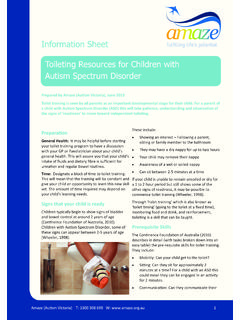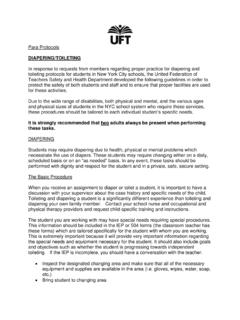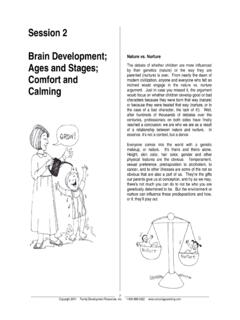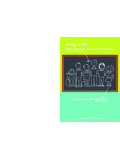Transcription of FUNCTIONAL MOBILITY & ACTIVITIES OF DAILY LIVING …
1 FUNCTIONAL MOBILITY & ACTIVITIES OF DAILY LIVINGC ourtney Silviotti, MS, OTR/LOBJECTIVES: FUNCTIONAL MOBILITY & ACTIVITIES OF DAILY LIVINGD efine FUNCTIONAL MOBILITY ACTIVITIES of DAILY LivingCompareADL Teaching StrategiesReviewImpact of Seating and PositioningExaminePopulation Specific Strategies Due to an injury or illness, muscles of the body may become weak/paralyzed or pain may limit movement. There are 3 main areas of FUNCTIONAL MOBILITY :WHAT IS FUNCTIONAL MOBILITY ?Bed MobilityTransfersAmbulationWHAT ARE ACTIVITIES OF DAILY LIVING (ADL)?Self Care or Self-Maintenance Tasks Oral Hygiene Personal Device Care FUNCTIONAL MOBILITY Sexuality and IntimacyWHAT ARE IADLS?
2 (INSTRUMENTAL ADLS) FUNCTIONAL Communication Using the phone & computer Caregiving Children, family, loved ones, pets Health Management Medication Routine Exercise Housework & basic home maintenance Finances Preparing meals Shopping Religious & Spirituality Transportation Driving or navigating public transitTEACHING ADL STRATEGIESALL DEPENDS ON THE Compensation for loss of function Adaptive Equipment Durable Medical Equipment (DME) Alternative StrategiesAdaptation: Remediation of FUNCTIONAL deficits Targeted impairment level interventions Repetitive practice of close to normal movementRecovery:..AND THE DIAGNOSISS trokeCardiacOrthopedicAmputeeCancerTraum atic Brain InjurySpinal Cord InjuryFOR BRAIN INJURYS trength/ROM Strength training Encouraged or forced use Dominance retraining One handed techniques Adaptive equipmentBalance Positioning Supine or Seated Seated or Standing Change amount of support providedVIDEO OF THERAPY SESSION: IN PRONESEATING AND POSITIONINGP romoting Engagement in FUNCTIONAL MOBILITY and ADLsIMPACT OF SEATING AND POSITIONING ON FUNCTIONS afetyPreventionAccessibilitySEATING AND POSITIONING: CUSHIONS AND PRESSURE MAPPINGPOSTURAL SUPPORTWHAT DOES PROPER SEATING & POSITIONING DO FOR YOUR PATIENTS?
3 Prevention Pressure Ulcers Postural abnormalities Flexible and Fixed Contractures Joint Injury Intervention Tool Pain Agitation FUNCTIONAL mobilitySTROKE/TRAUMATIC BRAIN INJURY:POSITIONING NEEDS FOR THE UPPER BODYGiv-Mohr SlingSplints Arm Trough/BoardSTROKE/TRAUMATIC BRAIN INJURY:POSITIONING NEEDS FOR THE LOWER BODYD orsiflexion wrap Braces or Orthotics(with ace wrap) to protect ankleLIMB LOSS:POSITIONING NEEDS FOR THE LOWER BODYSTRETCHING FOR POSITIONING:INSTRUCTING A FAMILY MEMBER Consult MD, PT, or OT prior to stretching Be aware of precautions THR precautions Shoulder elevation above 90 degrees Spinal ROM contraindications Preserving tenodesispattern Verify the physical health of the family member1)Isolate the movement at the desired joint2)Stretch the muscle into the desired range3)Stretch until mild resistance is felt4)Hold for 30 seconds5)Have family member return demonstrationContracture Tip: Stretch 1 minute after positioning of 1 hourACTIVITIES OF DAILY LIVINGF eedingToiletingGroomingDressingBathingFE EDING/DRINKING ADAPTIVE EQUIPMENTP late GuardsRocker KnifeDycemSTROKE/TRAUMATIC BRAIN INJURY.
4 FEEDING/DRINKING ADAPTIVE EQUIPMENTA ngled UtensilsProvaleCup Built-up UtensilsSPINAL CORD INJURY: FEEDING STRATEGIES BASED UPON INJURY LEVELW rist/forearm supportPlate guard, dycemPossible Mobile Arm Support (MAS)C5U-cuffAdapted utensilWean off adaptive equipmentC6 Adapted techniquesFinger WeaveC7 SPINAL CORD INJURY: FEEDING STRATEGIES May utilize with C4/C5/C6 tetraplegia Assists with tasks requiring against gravity planes of movement Mobile Arm Support (MAS) by JAECO Orthopedic Trial adaptive equipment Container management Alternative techniques for utensil management Cutting food Various food types Solids & liquids Finger foodsSPINAL CORD INJURY: FEEDING STRATEGIESSPINAL CORD INJURY: UTENSIL MANAGEMENT STRATEGIES Tenodesis Flexing of the fingers through tendon action of the extrinsic finger flexor muscles when they are stretched across the wrist joint during wrist extension.
5 Tenodesis splint Custom splint that assists the hand and wrist in performing tenodesisgraspFinger Weave Technique (C6, C7)BATHING:DURABLE MEDICAL EQUIPMENT Shower Seats With &without backs Tub Benches Padded & plastic Roll-in Shower Chairs Support (seatbelts, headrest, leg rests) Tilt &non-tilt featureDECREASED MOBILITY :ADAPTIVE EQUIPMENT FOR BATHINGLong Handled SpongeHand Held Shower Head& Grab Bars STROKE/TRAUMATIC BRAIN INJURY:ADAPTIVE EQUIPMENT FOR BATHING Hand Mitts Long Handled SpongesADAPTIVE EQUIPMENT FOR DRESSINGB utton Hooks Dressing SticksElastic LacesDECREASED MOBILITY :ADAPTIVE EQUIPMENT FOR DRESSINGLong Handled Shoe HornReacher Sock AidSTROKE/TRAUMATIC BRAIN INJURY:DRESSING STRATEGIESA llow for immediate successLoose fitting clothingFasteners: Limit or position on non-affected sideClothing in physical reach and intact visual fieldStable (seated or supine) positionOne-handed dressing strategiesDRESSING VIDEOSPINAL CORD INJURY:DRESSING STRATEGIESS table (seated or supine) position: bed, wheelchairEvaluate hamstring flexibility Back extensor muscle length for stabilityPromote lower extremity flexibilityPositioning & momentum for lower extremity managementIntroduce adaptive equipmentTOILETING.
6 DURABLE MEDICAL EQUIPMENT3-in-1 Commode Drop Arm CommodeStand pivot TransfersLateral TransfersSTROKE/TRAUMATIC BRAIN INJURY:TOILETING STRATEGIEST oilet tissue positioned on the unaffectedside for ease of accessUse modified fasteners or limit use of fasteners Snaps Elastic BandsTrial one-handed strategiesToileting Schedules Reduce urgency/ emergency situationsSPINAL CORD INJURY:TOILETING ADAPTIVE EQUIPMENT Clothing management Pants Clips Wheelchair skills Catheter management Clips Guides Mirrors UrinalsORTHOPEDIC:JOINT REPLACEMENT AND ADLS Total Hip Replacement Reinforce hip precautions during all tasks Anterolateral vs. Posterolateral Total Knee Replacement Encourage FUNCTIONAL movement of affected knee Squatting motion to reach for clothes from drawers) Extended leg for sitting/standingWeight bearing status Long handled equipmentAdaptive Equipment Elevated height DMED urable Medical Equipment Chairs with arms Proper FootwearSafetyPOSITIONING, TRANSFERS& MOBILITY Stand pivot Lateral With and without transfer board Ambulatory Dependent liftTransfer typesBODY MECHANICS DURING TRANSFERS: PROTECT YOUR BACKSTROKE/TRAUMATIC BRAIN INJURY.
7 TRANSFER STRATEGIES Facilitate anterior weight shifting Guarding technique/body mechanics Foot Placement Understand Neglect s Impact Cognitive visual perceptual deficit Only aware of the body, environment Impulsivity Proper foot placement Manual contacts Proper FootwearTRANSFERS VIDEOSPINAL CORD INJURY:TRANSFER STRATEGIES Facilitate anterior weight shifting Consistent/appropriate guarding technique Appropriate adaptive equipment Proper body mechanics Understand Key Concepts ASIA Classification Expected FUNCTIONAL outcomesRESOURCES Clinical Practice Guidelines (CPGs) created by the Paralyzed Veterans of America Cord Injury National Stroke Association Brain Injury Alliance of New Jersey Brain Injury ulcer prevention & treatmentSexualityAcute ManagementBladder ManagementRespiratory ManagementPreservation of Upper Limb FunctionAutonomic DysreflexiaFunctional OutcomesDepressionNeurogenic BowelSTROKE/TRAUMATIC BRAIN INJURY.
8 OTHER CHALLENGES TO ADDRESS Dysphagia Precautions Shoulder pain/subluxation G-Tube Visual perceptual deficits Cognitive impairments Behavioral challenges







